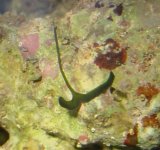A couple nights ago I noticed a solid green tentacle about 1 -2 mm thick and over 1 foot long coming out of one of my rocks. It has a forked tounge like appendage at the end. I have seen it retract back into a small hole in the rock and come back out again into the water column. I guess it belongs to some kind of worm but what kind.
I will try to get a picture up tonight.
Thanks
I will try to get a picture up tonight.
Thanks








